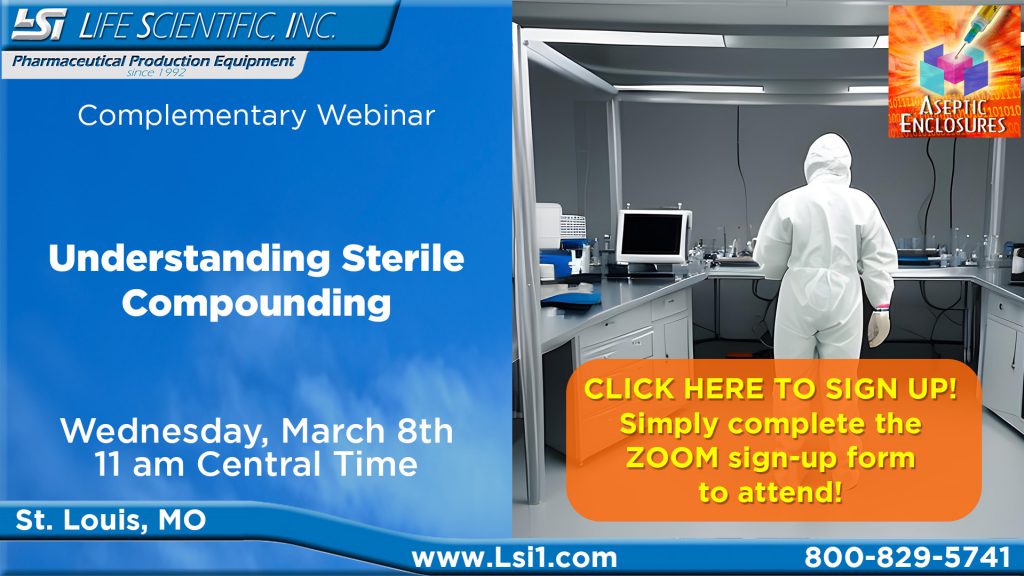Pharmacy compounding is the process of combining drug ingredients to prepare medications that are not commercially available or to alter commercially available medications to meet specific patient needs such as dye-free or liquid formulations. Pharmacists traditionally have prepared medications to fulfill individual prescription requests or manipulated reasonable quantities of human drugs on receipt of a valid prescription for an individually identified patient from a licensed practitioner. Some compounding is legal under state laws, and, when appropriate, FDA can exercise its enforcement discretion regarding new drugs and certain other requirements of the federal Food, Drug, and Cosmetic Act.
According to the Klevens, Richards, Edwards, Pub Health Rep 2007, there are more than 31,000 Hospital-acquired bloodstream infections each year out. The major source of contamination of any product inside the cleanroom is the person, aside from the other contamination sources such as the air, water, equipment and the raw materials and components.
A single person sheds more than 1.5 Billion flakes of skin a day. Knowing that the body constantly shed viable and non – viable particles into the environment, it is now mandatory to perform proper garbing and gowning. But even a Properly gowned person sheds more than 1000 CFUs per hour.
But how is that all contaminating the product and ends up being injected into your bloodstream?
Well, all humans and machines are prone to errors and mistakes. Many on-site investigations of random compounding pharmacies by state and federal regulators identified several instances of nonadherence to sterile technique. There are 483 warning letters from the state and federal authorities that surface every day and the “unsanitary conditions, including poor sterile production practices and failure to assure the sterility of the drugs produced” is an observation we are constantly hearing.
Over 70% of all bacteria collected can be directly linked to sources of the human body.
Aseptic Enclosures has developed a complete line of Compounding Aseptic Isolators (CAI) and Compounding Aseptic Containment Isolators as an alternative to the Biological Safety Cabinets for use in specialty compounding preparations. Our range of XLTC isolators and enclosures provide a better physical barrier between the pharmacy technician and the material that they are handling. These closed isolators are extremely more effective in protection of the health of the laboratory workers, are far more superior in maintaining the sterility of the process that is being carried out and prevent the contamination of the environment.
As demonstrated in other articles https://asepticenclosures.com/usp800vxltc800/ the closed containment cabinets are a suitable sterility upgrade that by putting a physical barrier between the handler and the material assures sterility of the final product even in cases of nonadherence to sterile technique and human errors.
Sterile compounding of preparations, like infection prevention, is a complex adaptive system that is also a social-technical system.
After determining that the human is the biggest particle shedder in clean environments it is smart to limit the number of particles that can end up contaminating the product and unfortunately cause serious blood infections. Putting the product in a sealed enclosure not only prevents direct exposure of laboratory personnel, it also prevents aerosol contamination and it stops pathogenic microorganisms from entering or escaping the cabinet. By placing the compounding process inside of a Compounding Isolator you’re limiting its exposure to particles that originate from the human body. The XLTC isolators do a great job in providing a more superior aseptic environment in pharmacy compounding and significantly improve sterility in common pharmacy practices.
The XLTC isolators are the most Aseptic Compounding Environment Available.
They are safer because the person is completely removed from the process, Wipe-down and staging both occur in a “fully isolated” ISO class 5 environment.
It’s faster to implement (no construction; receive, locate, install and train in 1/2 day) and to operate (no handwashing, no gowning, less cleaning).
And finally, it’s more economical to install (no clean room, no engineering, no architecture, less than $10,000 per work station) and to operate (Reduces garbing time and cost, maintenance costs, certification costs, HVAC costs, & microbiological testing, far less training required).

